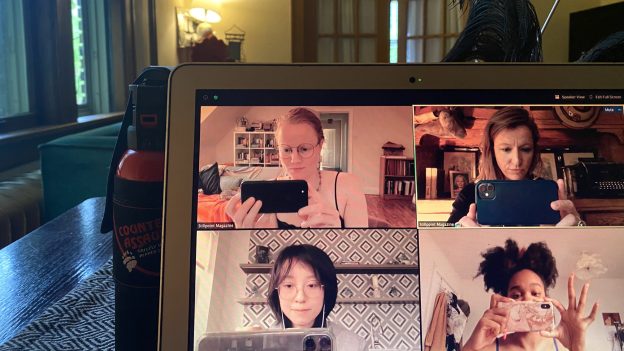Everyone has their pandemic tale. In mine, first there were the groceries. All around me the silent panic, eyes brimming with fear in the snaking grocery lines. And me, terrified, imagining I could return with my family, to some strange form of urban pioneering. There I was: buying pounds of flour, jars of honey, salt. Preserved vegetables. Candles. Lightbulbs. As if such trivialities, such practicalities, could save anyone from something so miniscule and massive as a virus.
Next, there was the sudden fall of eerie silence, the sound of abandonment, the stillness: rush hour, March 25, 2020, the streets vacant. “Like a movie,” we said—life and its reproduction on the silver screen caught in endless feedback loops. Then there came the dark, the solitude, the imperceptibly rapid spiraling out of control of all things, the boredom, the boredom. After that came the protests, the riots, the cities boarded up, the MAGA rallies, the trucks with their Confederate flags, and the smoldering of suspicion and discord like hidden wildfire spreading underground, through the rhizomes of the social forest, through the roots that connect us all. And with it all, there was the screen. Everything sutured and repurposed, truncated and remixed, GIFed and grafted and memed and filtered for the all-seeing screen, the eye.
In the beginning it seemed harmless enough, little windows peering into perfectly-arranged tableaux of perseverance: the breads, the crafts, the virtualized drinks and dates and friendship and sex and love. I did it myself: flung images of my children into the ether, busy with their falsely-perfect makeshift schooldays, and me, smiling for the camera, diligently at work beside them—Kate, Rashida, Summer, Stephen, my colleagues, my friends, an ocean or mere streets away—us all alone, building together this airplane as we flew it: Stillpoint Magazine.
In the beginning, we thought we were ahead of the game, we thought we had it made. We’d started Stillpoint Magazine remotely, floating thousands of miles apart. We knew each other, almost exclusively and through hundreds of hours of conversation, tens of thousands of keystrokes, as disembodied, talking heads. And our project too, our idea, was precisely what was happening all around us through waves of lockdown: inhabiting the digital, to render it more soulful, thoughtful, substantial, more humane. But as the months and year wore on, the seeds of doubt we each privately held—doubts about the relationship between the human and the machine—grew. And, as all parts of our lives were consumed, infiltrated, by the replication of experience, for the screen, we began to look directly into that omnipresent, digitized and mirrored eye, to ask: Who, or what, are you?
I am never able to offer some jovial yellow brick road at the end of ramblings like these. Even if there were a path to that glittering, technicolor castle, complete with singing hairdressers, a color-changing horse, and a woman in a floating bubble ready to bring us back to Kansas, simply by the force of our own nostalgia, well, I don’t know about you, but I would decline that kind of blue pill. And yet, perhaps, there is some sweet kernel here, at least for us at Stillpoint Magazine, at least in the depth of our grief, our hard-won knowledge, our begrudging acquiescence to the web and wave of the more-fully digitized existence that the pandemic brought forth. We’ve looked so long and hard at ourselves, held in that forever-present screen, that we have seen, not only the weaknesses, limits, and impossibilities within us, but also those in the digital itself.
So we want to ask a question, or a set of questions, borrowed from L. Ayu Saraswati and her book Pain Generation: Social Media, Feminist Activism, and the Neoliberal Selfie. Considering the limitations of the tools we use, and our own limitations as individuals floating in orbit around them…
Why do we imagine? Who do we imagine with and for? With which/whose tools do we imagine? How may we imagine outside the parameters of dominant discourses that provide us with the language/tool/cognitive machine for our imagination? Once we imagine “the otherwise,” how may we call it into being?
We will pose these questions to a number of our contributors previously published in Stillpoint Magazine, and will share their responses with you in next month’s Supporters’ materials.
Saraswati, L. Ayu. Pain Generation: Social Media, Feminist Activism, and the Neoliberal Selfie. NYU Press, 2021.
ANNE MARIE WIRTH CAUCHON editor
Anne Marie Wirth Cauchon is Editor-in-Chief of Stillpoint Magazine, and Creative Director of the PrairieCare Institute’s Center for Applied Psychoanalysis, the mother of two, a PhD candidate in English and Comparative Literature at the University of Minnesota, and the author of the novel Nothing.
© Copyright for all texts published in Stillpoint Magazine are held by the authors thereof, and for all visual artworks by the visual artists thereof, effective from the year of publication. Stillpoint Magazine holds copyright to all additional images, branding, design and supplementary texts across stillpointmag.org as well as in additional social media profiles, digital platforms and print materials. All rights reserved.



